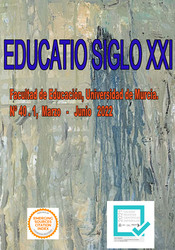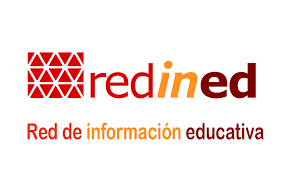Aprendizaje cooperativo en el aula de AICLE: retos percibidos por los docentes y recomendaciones para Educación Primaria
Resumen
Nadie pone en duda la popularidad de la cual goza el enfoque pedagógico denominado Aprendizaje Integrado de Contenidos y de Lenguas Extranjeras (AICLE), que requiere de una metodología flexible para el aprendizaje de contenidos y de lengua extranjera (LE). El Aprendizaje Cooperativo (AC) se muestra, de hecho, como una metodología ideal que cubre las necesidades de AICLE. El objetivo de este artículo es recopilar las percepciones de docentes AICLE con respecto a los retos que supone este enfoque cuando implementan AC en las aulas de primaria. Los informantes (n= 35) respondieron un cuestionario online de 25 preguntas (cerradas y abiertas). Los resultados de este trabajo reflejan los siguientes retos: uso de la lengua meta para la interacción; motivación; falta de tiempo; problemas de gestión potenciales; y evaluación. Por otro lado, los informantes declararon que para sentirse seguros a la hora de combinar ambos (AICLE y AC) necesitarían más formación al respecto. Además de presentar los retos percibidos por parte de los participantes, propondremos una serie de recomendaciones para cada curso de Educación Primaria con el fin de que arrojen luz a estos retos, dejando una puerta abierta para futuros estudios sobre AC en clases AICLE en otros países.
Descargas
-
Resumen1863
-
PDF 2239
Citas
Aronson, E. & Patnoe, S. (1997). The Jigsaw Classroom: Building Cooperation in the Classroom. New York: Longman.
Baloche, L. & Brody, C.M. (2017). Cooperative learning: exploring challenges crafting innovations. Journal of Education for Teaching, 43(3), 274-283.
Banegas, D. L. (2012). CLIL teacher development: challenges and experiences. Latin American Journal of Content and Language Integrated Learning, 5(1), 46-56.
Brady, I.K. & García-Pinar, A. (2019). Bilingual Education in the Region of Murcia: a qualitative study on teachers’ views. Estudios de Lingüística Inglesa Aplicada (ELIA), Mon.(I), 179-206.
Buchs, C.; Filippou, D.; Pulfrey, C. & Volpé, Y. (2017). Challenges for cooperative learning implementation: reports from elementary school teachers. Journal of Education for Teaching, 43(3), 296-306.
Campillo, J.M.; Sánchez, R. & Miralles, P. (2019). Primary teachers’ perceptions of CLIL implementation in Spain. English language teaching, 12(4), 149-156.
Casal, S. (2008). Cooperative Learning in CLIL Contexts: Ways to Improve Students’ Competences in the Foreign Language Classroom, in IAIE Cooperative Learning in Multicultural Societies: Critical Reflections, Turin (Italy), January 19-22. Retrieved from https://bit.ly/2Ixd3HX
Casal, S. (2016). Cooperative Assessment for Learning in CLIL Contexts. Estudios sobre Educación, 31, 139-157. Retrieved from doi:10.15581/004.31.139-157.
Coyle, D. (2006). Developing CLIL: Towards a Theory of Practice. In Monograph 6. Barcelona: APAC.
Coyle, D; Holmes, B. & King, L. (2009). Towards an Integrated Curriculum–CLIL National Statement and Guidelines. Retrieved from https://bit.ly/2ID5Y77
Coyle, D.; Hood, P. & Marsh, D. (2010). CLIL Content and Language Integrated Learning. New York: Cambridge University Press.
Cummins, J. (1979). Cognitive/Academic Language Proficiency, Linguistic Interdependence, the Optimum Age Question and Some Other Matters. Working Papers on Bilingualism, 19, 121-129.
Dalton Puffer, Ch. (2008). Outcomes and Processes in Content and Language Integrated Learning (CLIL): Current Research from Europe. In W. Delanoy & L. Volkmann (Eds.), Future Perspectives for Entglish Language Teaching (pp. 139-157). Heidelberg: Carl Winter.
Emmer, E. & Gerwels, M.C. (2005). “Establishing Classroom Management for Cooperative Learning: Three Cases” in Annual Meeting of the American Educational Research Association; Montreal (Canadá), April 11-15. Retrieved from http://files.eric.ed.gov/fulltext/ED490457.pdf
Gillies, R.M.; Ashman, A. & Terwel, J. (2008). The Teacher's Role in Implementing Cooperative Learning in the Classroom. New York: Springer.
Granados Beltrán, C. (2011). Facing CLIL challenges at university level. HOW. A Colombian journal for teachers of English, 18(1), 24-42.
Griffin, L.H. (2015). “Puzzling It Out: Teaching Marketable Skills in History Courses with the Jigsaw Technique”. Perspectives on History. The Newsmagazine of the American Historical Association, November 1. URL: https://bit.ly/2Vn3xNs
Holcomb, Z.C. (2017). Fundamentals of Descriptive Statistic. Routledge: New York.
Jacobs, G.M. (2004). Cooperative learning: Theory, principles, and techniques. 1st International Online Conference on Second and Foreign Language Teaching and Research.
Jacobs, G.M. (2006). Issues in Implementing Cooperative Learning. In S.G. McCafferty, G.M. Jacobs & A.C. DaSilva Iddings (Eds.), Cooperative Learning and Second Language Teaching (pp. 30-46). New York: Cambridge University Press.
Johnson, D.W. & Johnson, R.T. (1999). Making cooperative learning work. Theory into Practice, 38(2), 67-73.
Johnson, D.W.; Johnson, R.T. & Holubec, E. (1999). El aprendizaje cooperativo en el aula. Buenos Aires: Paidós.
Johnson, D.W.; Johnson, R.T. & Holubec, E. (2008). Cooperation in the Classroom. Edina, MN: Interaction Book Company.
Kagan, S. & Kagan, M. (2009). Kagan Cooperative Learning. San Clemente: Kagan Publishing.
Kagan, S. & McGroarty, M. (1993). Principles of Cooperative Learning for Language and Content Gains. In D.D. Holt (Ed.), Cooperative Learning: A Response to Linguistic and Cultural Diversity (pp. 47-66). Retrieved from http://files.eric.ed.gov/fulltext/ED355813.pdf
Lundin, Ch. & Persson, L. (2015). Advantages and Challenges with CLIL: a study eximining teachers’ thoughts on learner engagement and confidence within content and language integrated learning. Thesis manuscript. Retrieved from https://cutt.ly/tdUA5Ov
Madrid, C. (1993). Using Cooperative Learning at the Elementary Level. In D.D. Holt (Ed.), Cooperative Learning: A Response to Linguistic and Cultural Diversity (pp. 67-77). Retrieved from http://files.eric.ed.gov/fulltext/ED355813.pdf
McDougald, J. (2015). Teachers’ attitudes, perceptions and experiences in CLIL: A look at content and language. Colombian Applied Linguistics Journal, 17(1), 25-41. Retrieved from https://cutt.ly/zdUAvRk
McGroarty, M. (1993). Cooperative Learning and Second Language Acquisition. In D.D. Holt (Ed.), Cooperative Learning: A Response to Linguistic and Cultural Diversity (pp. 19-46). Retrieved from http://files.eric.ed.gov/fulltext/ED355813.pdf
Mertler, C.A. (2001). Designing Scoring Rubrics for your Classroom. Practical Assessment, Research & Education, 7(25), 1-8. Retrieved from https://pareonline.net/getvn.asp?v=7&n=25
Moss, R.F. (1992). What are the Benefits of Cooperative Learning in Content-based Instruction?. The Catesol Journal, 5(1), 113-117. Retrieved from http://www.catesoljournal.org/wp-content/uploads/2016/11/CJ5_moss.pdf
Muijs, D. (2011). Doing Quantitative Research in Education with SPSS. London: SAGE Publications Ltd.
Pastor Martínez, M.R. (2011). CLIL and Cooperative Learning. Encuentro. Revista de investigación e innovación en la clase de idiomas, 20, 109-118. URL: http://www3.uah.es/encuentrojournal/index.php/encuentro/issue/viewIssue/11/20
Pathak, V. (2013). Qualitative Research. Perspectives in clinical research, 4(3), 192. Retrieved from doi:10.4103/2229-3485.115389.
Pavón, V. & Ellison, M. (2013). Examining Teacher Roles and Competences in Content and Language Integrated Learning (CLIL). Linguarum Arena 4, 65-78. Retrieved from http://ler.letras.up.pt/uploads/ficheiros/12007.pdf
Pérez Cañado, M.L. (2018). Innovations and challenges in CLIL teacher training. Theory into Practice, 57(3), 212-221. DOI: 10.1080/00405841.2018.1492238
Pérez Vidal, C. (2013). Perspectives and lessons from the challenge of CLIL experiences. In C. Abello-Contesse, P.M. Chandler, M.D. López-Jiménez & R. Chacón-Beltrán (Eds), Bilingual and multilingual education in the 21st century. Building on experience (pp. 59-82). Bristol: Multilingual Matters.
Pescarmona, I. (2011). Working on cooperative learning: challenges in implementing a new strategy. International Journal of Pedagogies and Learning, 6(3), 167-174.
Shea, J.H. (2018). Problems with collaborative learning. Journal of Geological Education, 43(4), 306-308.
Slavin, R. E. (1995). Cooperative learning: theory, research, and practice. Boston: Allyn & Bacon.
Vega, M.V. & Moscoso, M.L. (2019). Challenges in the implemenation of CLIL in Higher Education: from ESP to CLIL in the tourism classroom. LACLIL, 12(1), 144-176.
Wood, D.; Bruner, J.S. & Ross, G. (1976). The role of tutoring in problem solving. Journal of Child Psychiatry and Psychology, 17(2), 89-100.
Zhou, H. (2012). Enhancing Non-English Majors’ EFL Motivation through Cooperative Learning. Procedia Environmental Sciences 12(B), 1317-1323. Retrieved from http://www.sciencedirect.com/science/article/pii/S187802961200429X
Derechos de autor 2022 Servicio de Publicaciones de la Universidad de Murcia

Esta obra está bajo una licencia internacional Creative Commons Atribución-NoComercial-SinDerivadas 4.0.
Las obras que se publican en esta revista están sujetas a los siguientes términos:
1. El Servicio de Publicaciones de la Universidad de Murcia (la editorial) conserva los derechos patrimoniales (copyright) de las obras publicadas, y favorece y permite la reutilización de las mismas bajo la licencia de uso indicada en el punto 2.
2. Las obras se publican en la edición electrónica de la revista bajo una licencia Creative Commons Reconocimiento-NoComercial-SinObraDerivada 4.0 Internacional (texto legal). Se pueden copiar, usar, difundir, transmitir y exponer públicamente, siempre que: i) se cite la autoría y la fuente original de su publicación (revista, editorial y URL de la obra); ii) no se usen para fines comerciales; iii) se mencione la existencia y especificaciones de esta licencia de uso.
3. Condiciones de auto-archivo. Se permite y se anima a los autores a difundir electrónicamente las versiones pre-print (versión antes de ser evaluada) y/o post-print (versión evaluada y aceptada para su publicación) de sus obras antes de su publicación, ya que favorece su circulación y difusión más temprana y con ello un posible aumento en su citación y alcance entre la comunidad académica. Color RoMEO: verde.











